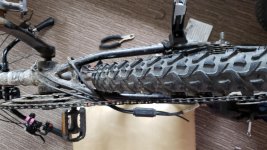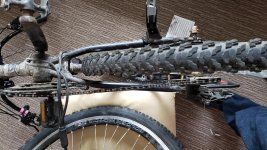It is possible that even a small difference at the axle could result in what looks like a significant difference at the tire, and it would also explain why the spacing is closer to equal at the seatstays and more unequal at the chainstays, assuming the filing you refer to is at the flats of the dropouts, and not the rounded part the axle seats into at the top (for vertical dropouts).
If instead the filing was done only at the rounded part the axle seats into, and not the flat area, then it would only affect teh chainstay spacing to wheel if the rounded part is at the front, for horizontal dropouts. If they're vertical, it wouldn't affect the chainstay spacing to wheel, but would affect the seatstay spacing to wheel, and the rack supports above the dropouts to the wheel.
FWIW, having to expand the flat part of the dropout isnt' normally needed, and enlarging by anything in the range of 2mm there would make an axle no longer be able to seat at a predictable angle to the frame.
(the flat part of the motor axle should be 10mm, the same width the dropouts should have started at, for most rear axles on most bike frames I've dealt with, that use regular threaded axles. For frames that use QR axles, they *might* be only 9mm, and might need a 1mm expansion, but there's usually some slop, and I've only had to remove the *paint* on the frame to fix the flat area clearance on most of the stuff I've stuck a hubmotor in. )
Having to expand the rounded part of the dropout by 2mm or more is not uncommon, however--it depends on the axle diameter of the threaded part of the axle (not the flats).
If the filing was uneven, then you can still make the axle even, simply by not pushing it all the way into the too-far-filed side. You can use the opening of the dropout to judge if the axle is seated evenly in each side, if they are symmetricaly designed. If not, you'd need another reference point that *is* symmetrical.
Or use the symmetrical reference point to correct the filing of each to make them even, and thus remove the problem.








